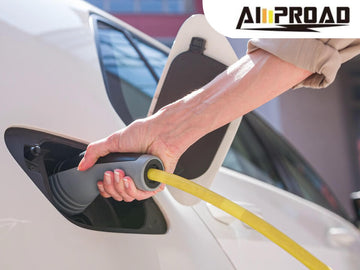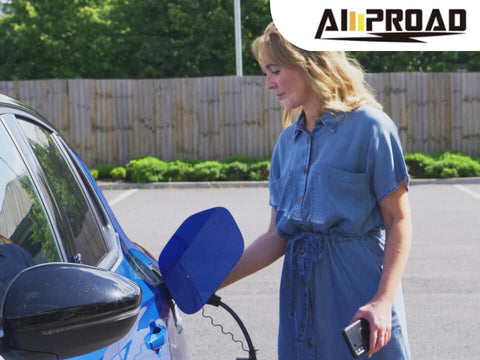
The North American Charging Standard (NACS) promises a future of speedy EV charging, but does it leave slower AC charging behind? This article delves into the world of NACS, exploring its capabilities and compatibility with the existing AC charging infrastructure we rely on today. Is AC charging still relevant with NACS on the rise? We'll explore the benefits of slower charging and how NACS might impact its future availability. Buckle up and get ready to navigate the evolving landscape of electric vehicle charging!
The North American Charging Standard
The North American Charging Standard (NACS) is generating a lot of buzz in the EV world. This new standard promises to streamline the charging experience by creating a universal connector for electric vehicles across North America. But with all the focus on faster charging, one question lingers: does NACS leave slower AC charging in the dust? Let's take a closer look at NACS and its relationship with AC charging.
Imagine the frustration of pulling up to a gas station only to find it dispenses a special fuel your car can't use. That's kind of what electric vehicle (EV) drivers face today with a mix of charging connector standards. NACS aims to solve this problem by establishing a single, unified charging interface. Think of it like a universal adapter for your phone – one standard that works with all charging stations. This standardization could significantly simplify EV charging, eliminating confusion about compatible connectors and potentially lowering costs for both consumers and manufacturers.
Does NACS Replace Existing Standards Like CCS?
Not necessarily! NACS is designed to be backward compatible, meaning it will still work with existing charging stations such as Tesla destination charger that use the CCS (Combined Charging System) standard, which is currently dominant for DC fast charging. However, NACS goes beyond CCS by introducing additional features and functionalities, including the potential for even faster charging capabilities. So, while NACS doesn't completely replace existing standards, it paves the way for a more unified and future-proof charging infrastructure.
Related article: North American Charging Standard (NACS)
NACS Capabilities

The true power of NACS lies in its versatility. While it excels at revolutionizing DC fast charging, it also embraces the role of AC charging, offering a one-stop solution for all your electric vehicle's charging needs.
What type of charging does NACS primarily focus on?
DC fast charging remains a major focus of NACS. These high-powered stations deliver a significant charge in as little as 15-30 minutes, making them ideal for long road trips or quick top-ups when you're on the go. By introducing a standardized connector and potentially enabling even faster charging speeds, NACS holds the potential to significantly reduce charging times and make electric vehicles even more convenient.
Can NACS handle both DC fast charging and AC charging?
Absolutely! NACS boasts a key advantage – the ability to handle both DC fast charging and AC charging using the same connector. This eliminates the need for multiple connector types, streamlining the charging experience for EV drivers.
Here's how it works
- DC Fast Charging: The NACS connector seamlessly connects to DC fast charging stations, delivering the high-power charge you need for quick refueling.
- AC Charging: The beauty lies in the NACS connector's versatility. It can potentially work with adapters or built-in functionalities to utilize existing AC charging infrastructure. This allows you to conveniently plug your car into a standard 120-volt or 240-volt outlet at home for overnight charging.
This ability to handle both charging methods with a single connector represents a significant advancement in EV charging technology. It offers convenience, flexibility, and the potential for a more comprehensive charging network in the future.
AC Charging's Role

AC (Alternating Current) charging is the slower charging method you might use at home overnight. It typically uses a standard 120-volt or 240-volt outlet and delivers a steady but slower charge compared to DC fast charging. While NACS focuses on faster charging, AC charging remains an important part of the EV charging ecosystem for several reasons:
What is AC charging, and why is it important for EVs?
Imagine waking up every morning with a fully charged electric car. That's the convenience AC charging provides. Here's how it works:
Home Charging: Many EV owners install a dedicated AC Level 2 EV charger at home, like the AMPROAD AC Level 2 EV Charger. This allows you to plug your car in overnight and wake up to a full battery, perfect for your daily commute or errands. These Level 2 chargers offer faster charging speeds compared to a standard outlet, significantly reducing charging times.
Widespread Availability: AC charging stations are more widely available than DC fast chargers. You might find them at workplaces, shopping centers, or even public parking lots. This makes them a convenient option for topping up your battery while you're on the go.
Are there advantages to using slower AC charging over DC fast charging?
Absolutely! While DC fast charging offers undeniable speed, AC charging holds its own with some distinct advantages:
- Cost-Effectiveness: AC charging is generally cheaper than DC fast charging. This is because the electricity used for AC charging comes from the grid, while DC fast charging stations require specialized equipment and infrastructure.
- Gentler on Battery: Slower AC charging is considered less stressful on your EV's battery compared to the rapid influx of power from DC fast charging. While occasional DC fast charging is perfectly fine, regular use of AC charging can potentially help prolong battery life.
- Convenience: Having a dedicated AC charger at home or access to one while you're out provides a convenient way to keep your battery topped up without needing to seek out a dedicated DC fast charging station.
As per the exploration, NACS and AC charging offer complementary solutions for electric vehicle charging. NACS excels at providing a fast and convenient option for long trips or quick top-ups, while AC charging remains a cost-effective and battery-friendly way to keep your car powered for everyday needs. The ability of NACS to potentially work with existing AC infrastructure further strengthens this partnership, paving the way for a future with a more comprehensive and user-friendly charging experience for all EV drivers.
NACS and Beyond

We've explored the capabilities of NACS and its relationship with AC charging. But how will this new standard impact the future of EV charging? Let's delve into the potential implications of NACS on the availability and significance of slower AC charging options.
NACS promises a revolution in EV charging with its focus on faster charging speeds and a unified connector. However, this begs the question – will NACS render AC charging obsolete?
How will NACS potentially impact the availability of slower AC charging options?
The impact of NACS on AC charging availability remains to be seen. Here are some potential scenarios:
Increased Focus on DC Fast Charging: With NACS streamlining the DC fast charging experience, there might be an initial focus on building more DC fast charging stations. However, this doesn't necessarily mean AC charging stations will disappear.
Improved Infrastructure Compatibility:NACS' potential compatibility with existing AC infrastructure could lead to these stations being integrated into the NACS network. This could enhance their visibility and potentially encourage investment in maintaining them.
Focus on Home Charging: AC charging remains the dominant method for home charging. With the convenience of overnight charging, home AC charging options like the AMPROAD AC Level 2 EV Charger are likely to remain important for EV owners.
Overall, NACS might not directly decrease the availability of AC charging stations. Instead, it could potentially lead to a future where both types of charging coexist, with a focus on building a more comprehensive and accessible charging infrastructure that caters to both fast and slow charging needs.
Will the need for daily AC charging diminish with the rise of NACS and other fast-charging technologies?
Probably not. While advancements in battery technology and faster charging options like NACS are promising, AC charging is likely to remain a vital part of EV ownership for several reasons:
Cost-Effectiveness: AC charging remains significantly cheaper than DC fast charging. For everyday needs, using AC EV home charger or readily available public stations can be a more budget-friendly option.
Battery Health: Regular AC charging is considered less stressful on an EV's battery compared to frequent DC fast charging. While DC fast charging is convenient for occasional use, AC charging can potentially help maintain optimal battery health in the long run.
Convenience: Having a dedicated AC charger at home or access to public AC stations offers a convenient way to keep your car topped up without needing to seek out a DC fast charging station, especially for shorter trips or errands.
The Future of Charging
The rise of NACS and other fast-charging technologies signifies a shift towards faster and more convenient charging options. However, AC charging is likely to hold its own as a cost-effective, battery-friendly, and convenient way to keep your EV powered for everyday needs. In an ideal future, NACS and AC charging will work together to create a robust and user-friendly charging infrastructure that caters to the diverse needs of EV drivers.


